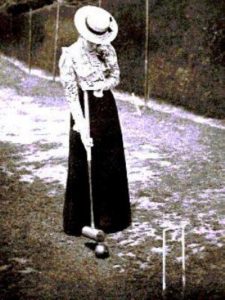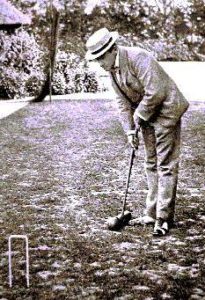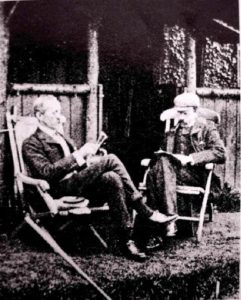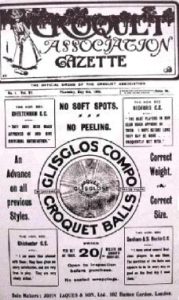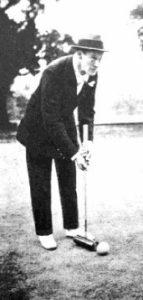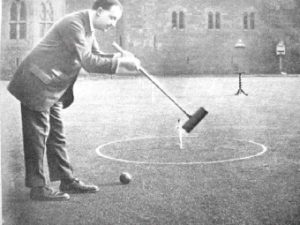The contributor who signed himself “NOT GEORGE” submitted no less than five short stories to the Croquet Gazettes of 1912 and 1913. They were all about a fictitious character named Professor Ibbelgen. The first story was published in last year’s SWAN. This, the second story, appeared in the Croquet Gazette of 24th October 1912 – Allen Parker.
It is said that we are all mad on some subject, however sane we may be on all other matters, and I had a curious instance of this in connection with the occurrences that environed my second meeting with Professor Ibbelgen.
I was beginning my croquet season this year with the Spring meeting at Southdown. My friend Asquith, who had been spending the winter abroad with his bride, was coming too, and a number of other croquet friends, so that I expected a very pleasant week’s croquet.
The meeting did not begin until Tuesday, so I travelled down from town on Monday, and had an invitation to dine that night with a rather well known local player named Philemon.
This individual, a bachelor who lived in a large house overlooking the croquet grounds, was, I think, the keenest croquet player I have ever met; he appeared to think of and live for nothing else. His handicap was ½-bisque, and his great ambition was to be a minus-bisquer.
There was a rumour that on one occasion he had asked his adversary in the final of an “A” open event to dine with him before the match, and had done him so extremely well that his opponent, instead of being merely put off his game a bit (as rumour said his host had intended), had been obliged to scratch and interview the doctor next morning instead of the referee.
I did not attach any credence to this story, and had no hesitation in accepting the invitation of Philemon, whom I had always found a most agreeable, witty and entertaining companion.
When Philemon’s party had assembled that Monday night, I found a pleasant gathering of men croquet players, the only stranger being the Professor Ibbelgen whom I had met at Eastbourne last autumn. He appeared to take a great interest in croquet, and told me that he considered that really scientific croquet could only be played on an absolutely true surface, such as a sheet of ice, and he said that he had found that hollow iron balls covered with cork, on such a surface, made an excellent game.
“We had a most interesting tournament in Stockholm last February”, he said; “it was only marred by the accidental drowning of the referee, which occurred through his walking on thin ice, when called upon to decide a very doubtful point”
I noticed during dinner that the men present were all those in Philemon’s half of the draw in the “A” singles, and I wondered if there was anything in the aforementioned rumour. However, the dinner was excellent and at its termination no one appeared to have taken more than a moderate amount of wine.
Before we settled down to bridge, as we all stood chatting in the smoking room, the conversation turned somehow to hypnotism. “My friend Ibbelgen here”, said Philemon, “is a dab hand at it, and I believe, could hypnotise a cat”.
Presently it came out that Ibbelgen could in some cases hypnotise people against their will, and as he was challenged to try the present company, he made us all sit down, and then produced a longish, narrow metal funnel, with a small electric bulb above the narrow end.
He placed the narrow end to his eye a short distance away from it, and the wide end he presented to each of us in turn, and we gazed at his eye for about 60 seconds, it seemed to me. He then said “Well I can’t do any thing with you now; you are all too strong willed. I really believe that croquet has a tendency to strengthen the will, as I have often noticed the peculiar obstinacy of a croquet player in sticking to his opinion, even when the referee has given a decision against him”.
We then settled down to bridge, at which the professor was a topping player, whatever he may have been at croquet on the ice. At 11.15 the party broke up after a most pleasant evening.
Next day the tournament began. Philemon beat me somewhat easily on Wednesday in the “A” opens, but not owing, I am sure to his excellent dinner on Monday, as everyone on Tuesday morning was as fit and flourishing as possible.
On Thursday morning Philemon met Asquith, and each won a game. In the third game Philemon, getting the balls at once, made a nice break to 4-back with his red, he then took his yellow to 3-back, having peeled the red through 4-back with some difficulty on the way. He broke down at 3-back and let Asquith in. The latter took blue to 4-back, and, as Philemon failed to hit in, appeared likely to go out with black. He had peeled blue through 4-back, when I noticed Philemon lift his hat and wipe his forehead, and I knew how bitter his disappointment would be if he were knocked out.
Directly after this Professor Ibbelgen appeared on the ground, and came and sat near the winning peg. Asquith continued his break with black, peeled blue through the penultimate, and left it near the rover hoop. In attempting to peel it through the rover hoop, he failed, so ran the hoop himself and laid up to go out next turn, wiring both red and blue from yellow. Philemon again shot and missed. Asquith then roqueted red with blue, both lying close to the rover hoop, but, to everyone’s stupefaction, he proceeded to lay up for and run the rover hoop the reverse way.
Philemon stalked on to the court, and after a short discussion, the referee was called. It then appeared that after some further discussion Asquith saw his mistake, which he had been unable to do before. “What a donkey I am, must be a touch of the sun, I think,” he said. “Sorry to have bothered you,” to the referee. Philemon did the last two hoops with red and pegged black out, and then finished the game with yellow.
In the afternoon Philemon played against Follette; the latter was shooting very well, but kept on playing with the blue ball of his opponent instead of with his own red. He must have done this five or six times, and lost both games thereby.
The professor, who was sitting near me, said, “Is it that our friend is colour blind?” It certainly looked like it that afternoon. Winning this event put Philemon in the final, and as it turned out he had to meet Mrs Asquith on Saturday morning. She had been playing very well, and had certainly not needed any eyewash to help her shoot, as her shooting across the ground had been one of the features of the tournament.
She won the first game somewhat easily. Philemon looked like winning the second, when Mrs. Asquith shot in, went round and was just about to peg Philemon’s live ball out, when, just as she swung forward for the hit, she let go her mallet, knocking the two balls to either side of the peg, and seized her left hand with her right, saying, “A bee has stung me.” Her friends crowded round, and it appeared that there was an irritating little red mark the size of a threepenny piece on her hand, but no sting as far as we could discover. “I didn’t see the bee,” said Mrs. Asquith, “I only felt it.”
I myself had been rather close and had noticed a curious kind of flash near Mrs. Asquith’s hand just as she dropped her mallet.
Philemon went on and won the game. In the third game Mrs. Asquith suddenly dropped her mallet, again complaining of a bee having stung her. There was another little red mark on her hand, rather near the first one, and again I was certain I had seen something in the air near her. The general opinion was that it must have been some kind of large gnat or dragonfly which had stung her, and we were all much puzzled.
Anyway the double sting quite put Mrs. Asquith off her game, and she kept looking round, and seemed to be paying more attention to the imaginary bee than to her game, with the natural result that Philemon won somewhat easily.
He had barely pegged out when there was a crackling noise at the other end of the court, and the turning peg was seen to be wreathed in flames burning fiercely.
Whilst people were crowded round wondering how it had caught fire, there was another crackle on the next lawn, and the winning peg, just as a player was pegging his adversary’s ball out, burst into smoke and flame.
The referee was appealed to later on to decide whether it was a peg out or not, but as the striker’s opinion was amply corroborated by the scorched condition of the front ball, he had no option but to give it in the striker’s favour.
Meanwhile, I had been keeping my eyes open, and the moment the first peg caught fire, I bolted out of the ground and hurried to Philemon’s house. “Is Professor Ibbelgen in?” I asked the footman. “He’s in the observatory, Sir,” replied the footman, referring to a room in a high tower in the house where Philemon kept his big telescope. “Don’t trouble to come, I know the way,” I said, and rushed up the stairs to the observatory. Unceremoniously dashing into the room, I surprised the Professor, as I had hoped to do, in front of a curious large instrument in front of the window overlooking the croquet ground.
“Now Professor,” I cried, “the game is up, and unless you want to get into serious trouble, you must make a clean breast of everything. I am sure you burnt those posts and hurt Mrs. Asquith’s hand, as I saw a gleam coming from this window.”
The Professor, who I am sure had been reluctant to keep his invention secret, and was rather pleased than otherwise at being found out, at once caved in.
“Well Mr. Washington, “ he said, “ our friend Philemon is, as you know, very anxious to get his handicap down at croquet. He had heard of me in connection with my celebrated eyewash, and was much disappointed when he found it was no good to him. I am, however, as you may guess, a somewhat ingenious man, and I told him that, for a consideration, I had two other ideas which would help him to achieve his end. That night when you dined here, I did really gain sufficient hypnotic power over you all, by my instrument, to have the power of distorting your judgement, at any rate for a few days. And this instrument I have here is an elaborate and extremely powerful burning glass. I call it a helioball. The sun’s rays fall into this immense and somewhat oval reflector, they are thence reflected into this row of lenses, most of which are in pairs, and have water enclosed between them. In the water I have a certain preparation, and in the partial refraction that takes place, the non-heating part of the sun’s rays is eliminated*.
By these means, and with this telescope sighting apparatus, I can throw a ray of burning light, intermittent or otherwise, a considerable distance, and to an exact point.
By throwing certain numbers of the lenses out of action, I can lessen the heat of the rays I throw. By careful experiment, I ascertained exactly how powerful a ray it was necessary to throw in order to cause pain to a player’s bare skin on the courts below. Unfortunately your quick eyesight detected the gleam, and as I saw you look up here, I burnt the posts in the hope that your attention would be distracted, and you might think the phenomenon some extraordinary effect of the sun’s rays direct. I was to receive £100 from Philemon for my services.
I told the Professor that the sooner he retired to his own country and devoted his attention to ice croquet, the better it would be for him, as I was not sure whether he would be prosecuted or not.
There was a painful scene between Philemon and the club committee. The former was known to be an honourable and upright man in every possible way outside croquet, but on this subject he was undoubtedly mad.
Eventually Philemon gave a solemn undertaking that he would never play in a tournament again. The committee decided not to proceed against Professor Ibbelgen for Philemon’s sake.
Mrs. Asquith summed up our feelings towards the Professor pretty well that evening, when after a discussion of all the circumstances, she said, “Well, I am rather sorry he isn’t going to prison after all, because then at least he would have got his hair cut!”
*Note. Quite the opposite would happen. The water would absorb part of the heat. [AP]
